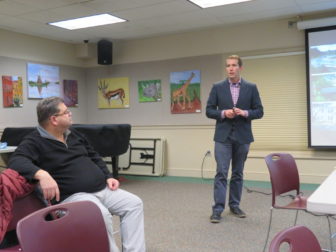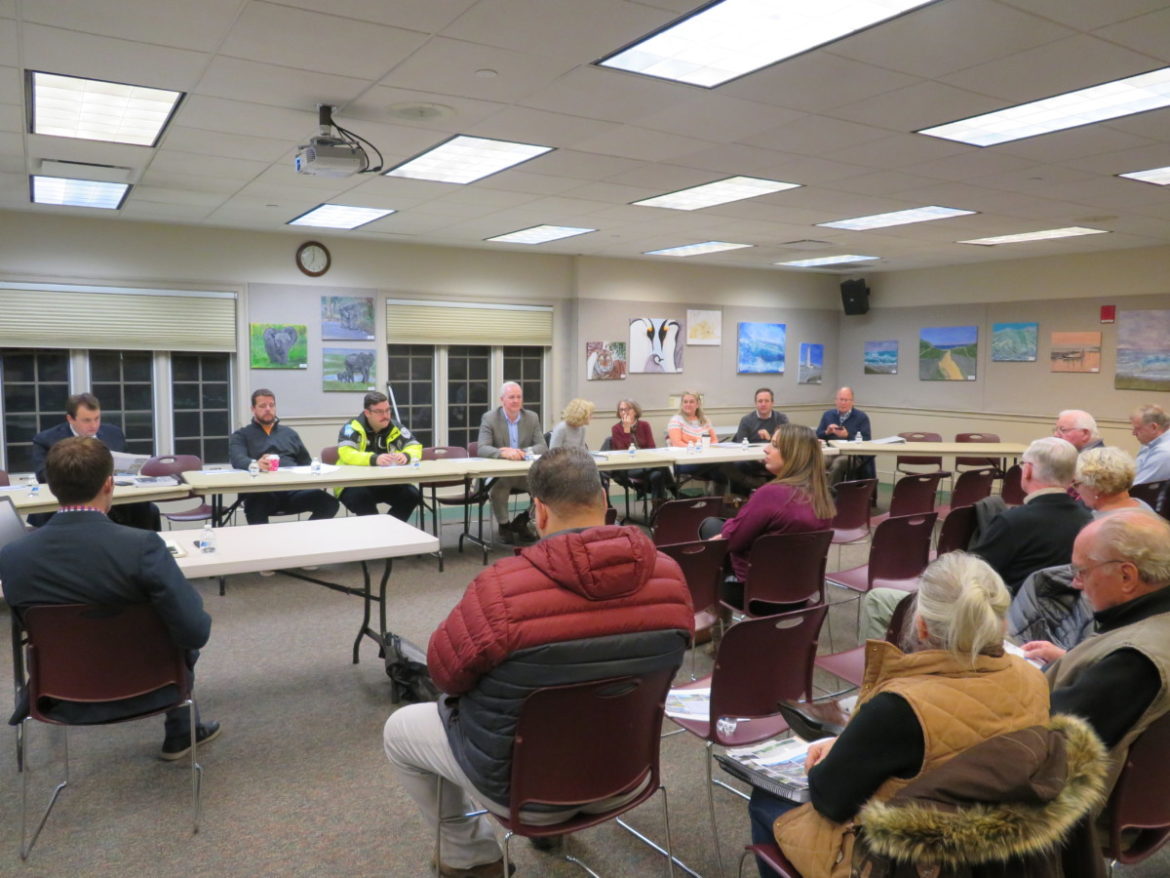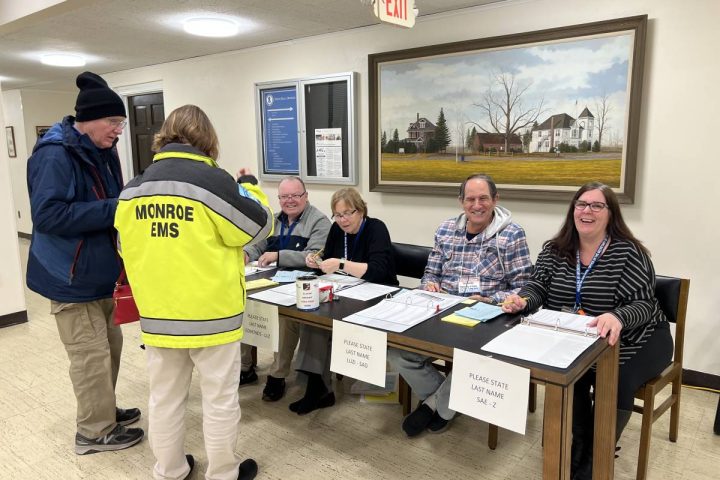Periods of heavy stop-and-go traffic on routes 25 and 111 and over-development with large septic systems too close to rivers in some parts of town were among the concerns expressed by residents attending a meeting on Monroe’s Plan of Conservation and Development at Edith Wheeler Memorial Library Wednesday night.
Town officials are seeking public input, while the Planning and Zoning Commission’s POCD Committee begins the process of updating and revising the plan.
Chairman William Porter said the POCD is the master plan that zoning and development follow, adding it must be updated every 10 years.
“It’s not a regulation. It’s a guideline,” he told the 20 people seated in the Ehlers Meeting Room. “It’s important to get input from the town on what they want the guidelines to be. There will be opportunity for input throughout the process.”
Town Planner Rick Schultz also encouraged public input and for residents to routinely check the town website for updates on the progress of revising and updating the POCD. The page on the website is also where they can also find meeting dates allowing them to participate more.
Francisco Gomes, a project manager and urban designer with Fitzgerald & Halliday, Inc., the Hartford based consultant hired by the town, said his firm will also put together an online survey that residents can take on their cellphones in only 10 minutes.
Gomes made a presentation outlining the goals of the update, as well as the timeline.
“Our goal is to land this ship this time in December of next year,” he said. “We want an updated POCD by December of 2020.”
A draft of the POCD should be submitted to the Town Council and the Connecticut Metropolitan Council of Governments by Oct. 10, 2020, and the plan should be posted on the town website with a hard copy in the Town Clerk’s Office by Nov. 9, according to the timeline.
Gomes said the town must hold a public hearing on the plan by Dec. 14, 2020 and submit a final plan to the state Office of Policy and Management no more than 60 days after that. Gomes said the town will not be eligible for state grants without an updated and revised POCD on file at OPM.
Ultimately, the Planning and Zoning Commission will vote to adopt the final plan.
Areas of focus

Gomes said he and his team will be spending a lot of time gathering information about Monroe, using data from the U.S. Census as a baseline, as well as local and state information.
“Every community is unique, so there is a learning curve for us,” he said. “I look forward to learning more about your community for the plan of the next 10 years.”
Gomes said the POCD looks at where Monroe was and is as a community, and where its residents want it to go. Rather than just taking a snapshot of the town, his firm will look at historical trends over the past 10 years.
The data will be used to inform the input from town officials and residents. For example, if there is a belief that growth is out of control, Gomes’ firm will look at things like student enrollment statistics and a traffic analysis to determine if the concern is valid or just a perception.
The special areas of focus will be: “Commercial Corridors, Priority Growth/Village District Areas, Mixed-Use Development, Redevelopment Sites, Regulatory Review and GIS Integration,” according to Gomes’ presentation.
Gomes said the planning process should build upon the 2010 POCD and revisit the following priorities:
- Managing of future growth along routes 25, 111 and 34 while promoting “measured and attractive economic development.
- Enhancing Monroe’s historic and rural character
- Protecting the town’s quality of life as a good place to live and raise families
- Enlarge the parks, open space and trail system to create a Monroe Greenway with recreation and relaxation opportunities for all residents
- Exercise stewardship over Monroe’s natural features, such as wetlands, streams and Lake Zoar
- Conserve land and natural resources
Among the subject areas the plan covers will be housing, transportation, town facilities and services, open space and environment, cultural and historic resources, and economic development.
Once the consulting firm understands the basics of the community, they will look at the issues. Gomes said “the POCD should be the definitive statement of how Monroe wishes to see itself evolve over time and how it will get there.”
Gomes said there will be focus group meetings with key stakeholders, as well as a big public workshop in the spring, adding the goal is for sometime in April.
“We take all of that information into a summary of issues people agree on and don’t agree on. That is where the real work is,” he said. “We need guidance from you as a community to tell us what the priorities are.”
Traffic, redevelopment
During a question and answer period, Ronald J. Bunovsky Sr. said he did not see anything in the presentation on how to handle waste water and storm water, which he said is a problem with numerous septic systems being over 50 years old. Bunovsky also said there is overdevelopment where systems are not set back properly from rivers.
Gomes said those concerns would be under “environment and open space” in the plan.
Bunovsky said the town’s road structure should also be looked at with the possibility of not having curb cuts in some areas. Lee Hossler, who serves on the Monroe Economic Development Commission, agreed, adding transportation and economic development go hand-in-hand.
At certain times of the day, Hossler said traffic is heavy on routes 25 and 111 and traffic lights are not coordinated, so drivers get stuck in stop-and-go traffic.
Gomes said traffic studies that have already been done for the Route 111 and Route 25 corridors will be looked at again to see if there are any recommendations that could improve Monroe’s situation.
John Kimball, a developer in town, said maps need to be updated to accurately show what land can actually be developed and what is protected open space. He also said the town must decide how to redevelop properties for reuse, such as areas with strip retail that seem to be “dying on the vine.”
Bunovsky said any mentions of hooking into the sewer line with Trumbull and Bridgeport should be removed from the POCD, because that is not something that will happen over the next decade.
The survey
Gomes said his staff will come up with the questions for the community survey, though finalizing it will be a process of about two to three weeks of considering public input and going back and forth with town land use staff.
“We want to put something together that someone can get through in 10 minutes,” he said.
Gomes said the survey is only one aspect of what will go into the POCD update, adding it will not be statistically significant. He said he hopes to get 1,000 completed surveys.
Barbara Fahr asked if there will be a way to determine what part of town those who respond are from, so the results are not skewed toward one section. Gomes said there will be questions to help determine where people are from without being too personal.
Gomes said lawn signs, press releases, social media, fliers, mailers and post cards can be effective in getting the word out about the survey. Residents will also be able to take it at the library and Town Hall.
If the Board of Education allows them to do so, Gomes said notices can be put in students’ backpacks to take home.
“We’ll do everything we can to bring the horse to water,” he said.
Jennifer Aguilar, a Town Council member attending the meeting, asked if the names of the POCD Committee members could be included on the town website. Porter said it will be.
Members attending Wednesday’s meeting included Porter, Planning and Zoning Commission member Leon Ambrosey, Planning and Zoning Commission alternates Robert Westlund and Ryan Condon, former first selectman and current chairwoman of the Conservation Commission Karen Burnaska, Conservation Commission members Barbara Thomas and Ryan Driscoll, Town Councilman Jonathan Formichella, Monroe Chamber of Commerce president and Monroe Economic Development Commission Chairman Raymond Giovanni, and Tammi Julian, past president of the Monroe Parents Council.
First Selectman Ken Kellogg also attended the meeting.






